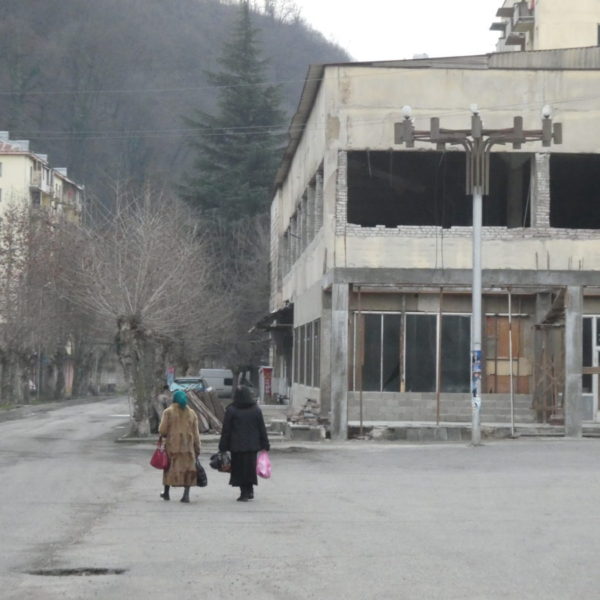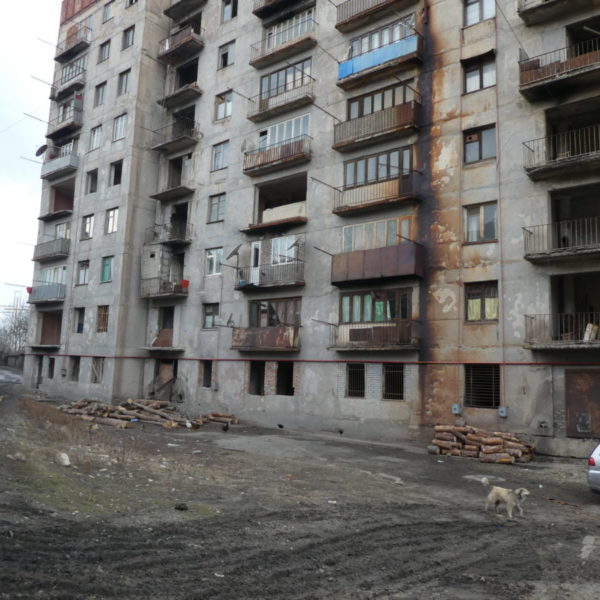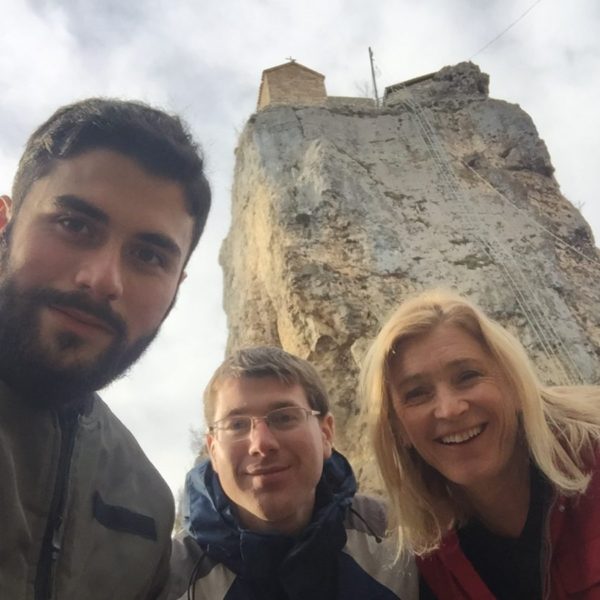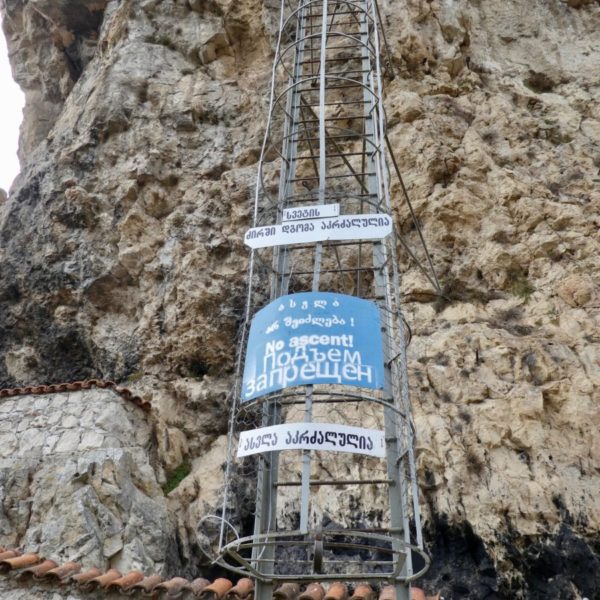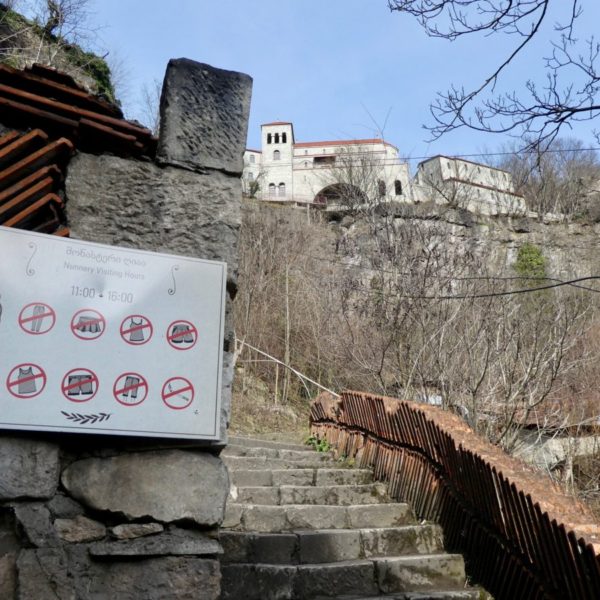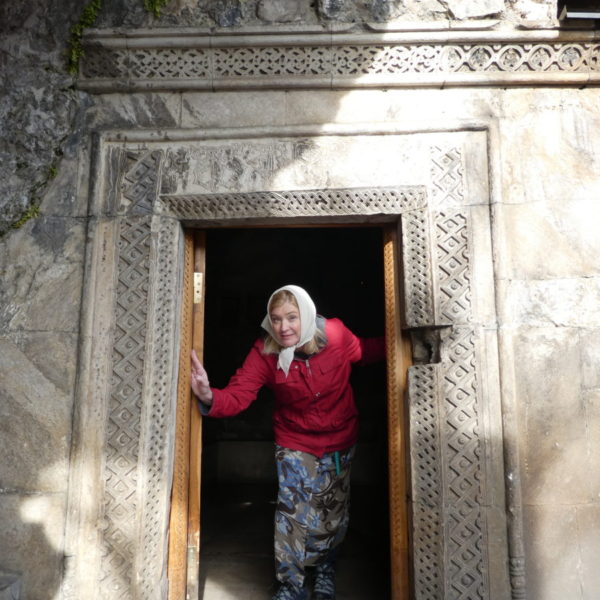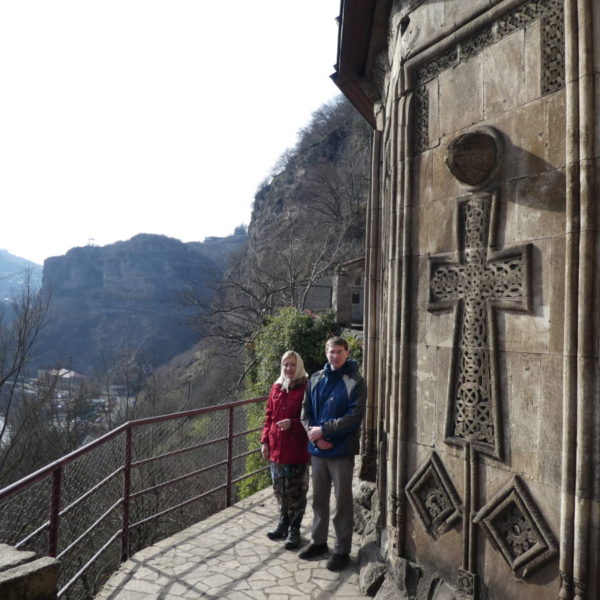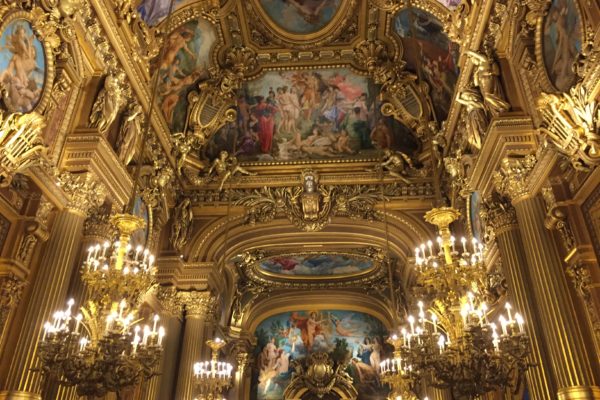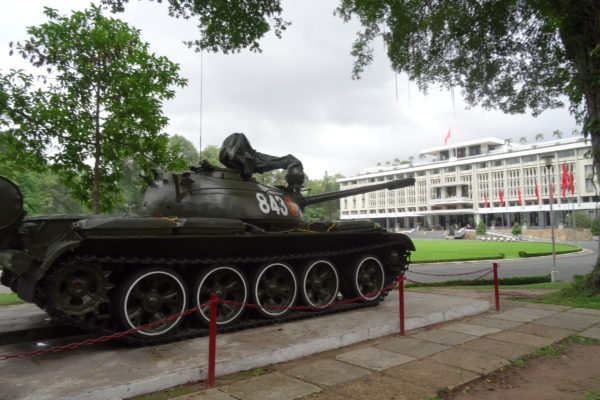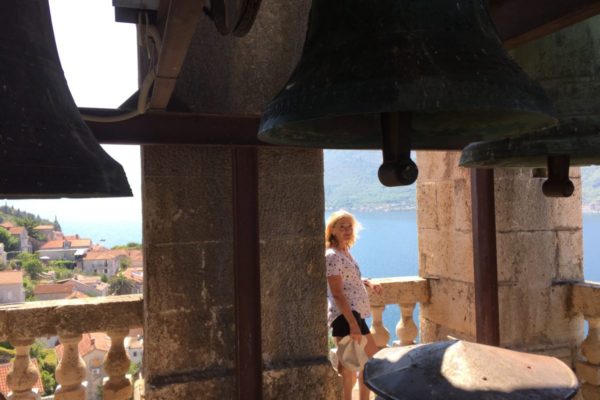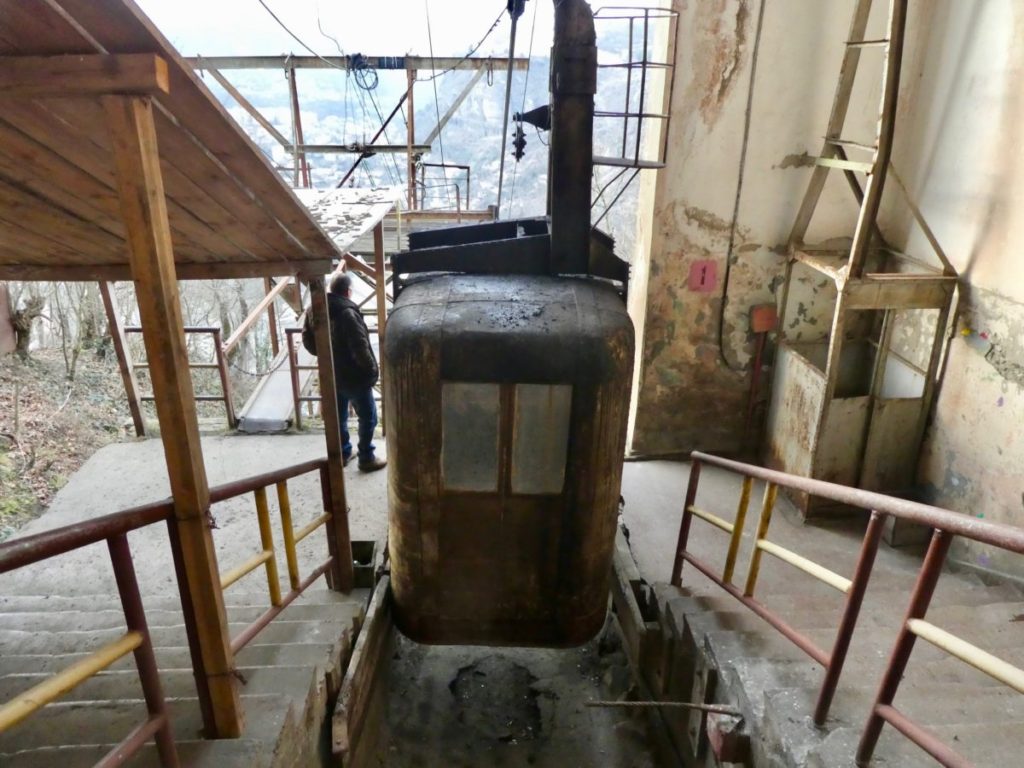

The ride on the Chiatura cable cars was free. On the other hand, we could die.
Welcome to the gritty mining town in the foothills of the Greater Caucasus mountains that was home to a rusty network of cable cars, nicknamed the “flying coffins.”
Update: Since my 2019 visit, the main cable car station has been renovated and many of the “flying coffins” have been replaced by modern cable cars. However, it’s still a dramatic — but safer — ride. Chiatura is still well worth a visit for the nearby Mgvimevi Monastery and the Katshki Pillar, as well as the Soviet-era atmosphere of the town itself..
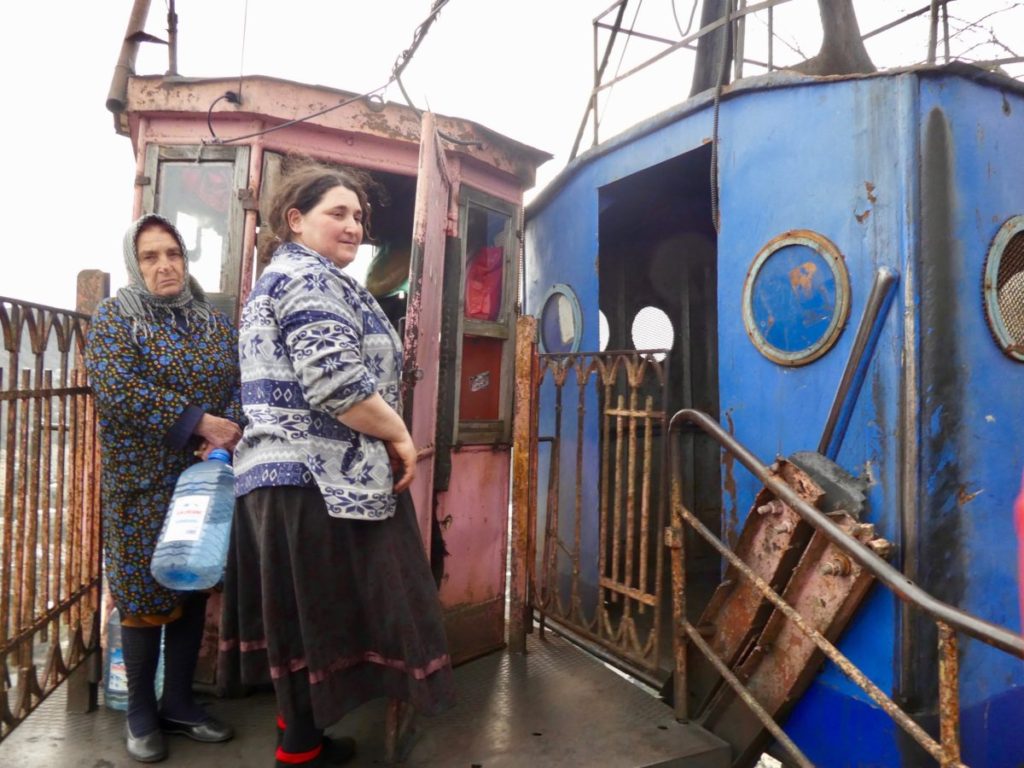
Local residents rely on the rusty buckets as free public transit between their homes and jobs.
Chiatura’s Manganese Mines
The blue-collar town you see today is only the ghost of a once-thriving mining center on the banks of the Kvirila River in the Eastern European country of Georgia, current local population about 12,000. Manganese, an essential ingredient in the production of heavy weapons, was discovered here in the 19th century.
By some estimates, Chiatura produced more than 50% of the entire world’s supply of manganese and accounted for about 75% of Georgia’s economy. Abandoned mining or barely working facilities now dot the landscape like iron dinosaurs.
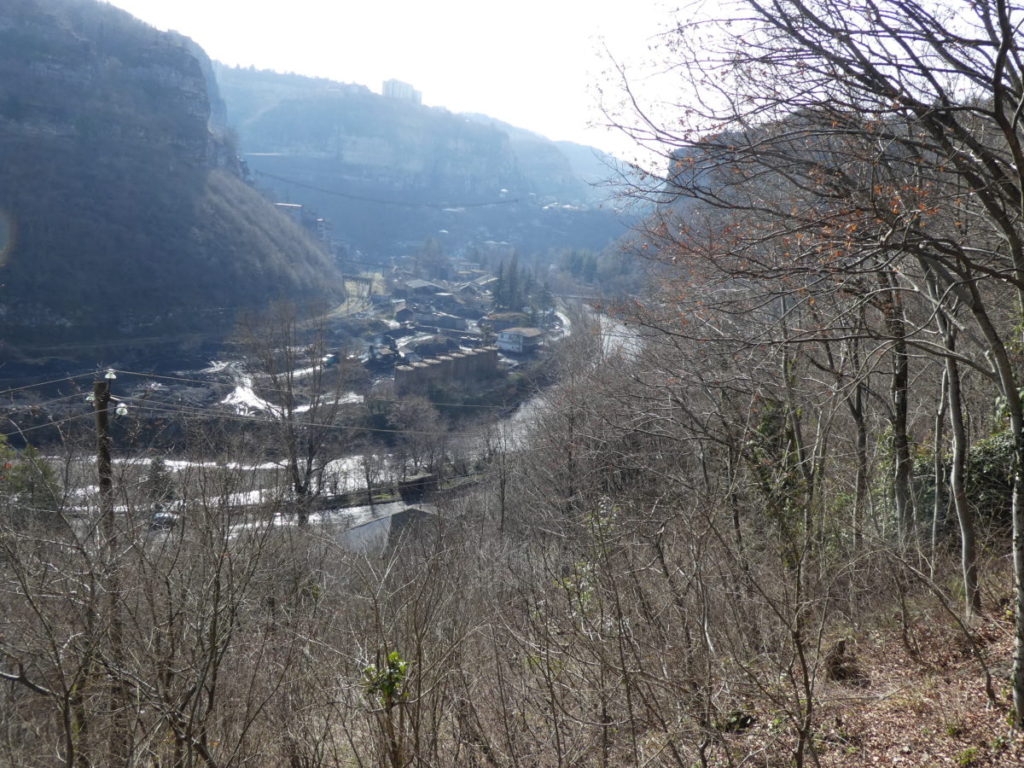
The valley near Chiatura is lined with manganese mining facilities. Only a few are still operating.
The Stalin Connection to Chiatura
Josef Stalin, under the code name “Koba,” recruited local Bolsheviks and hid out here before the Russian revolution. During the decades when Georgia was an outpost of the Soviet Union, it was said that Chiatura always held a soft spot in the ruthless dictator’s heart. He knew from personal experience that weary miners had to scramble up and down the steep cliffs to to reach their work and their homes. The cable cars were planned prior to his death in 1953 and began operating in 1954 — the first public transportation system of its kind in the Soviet Union.
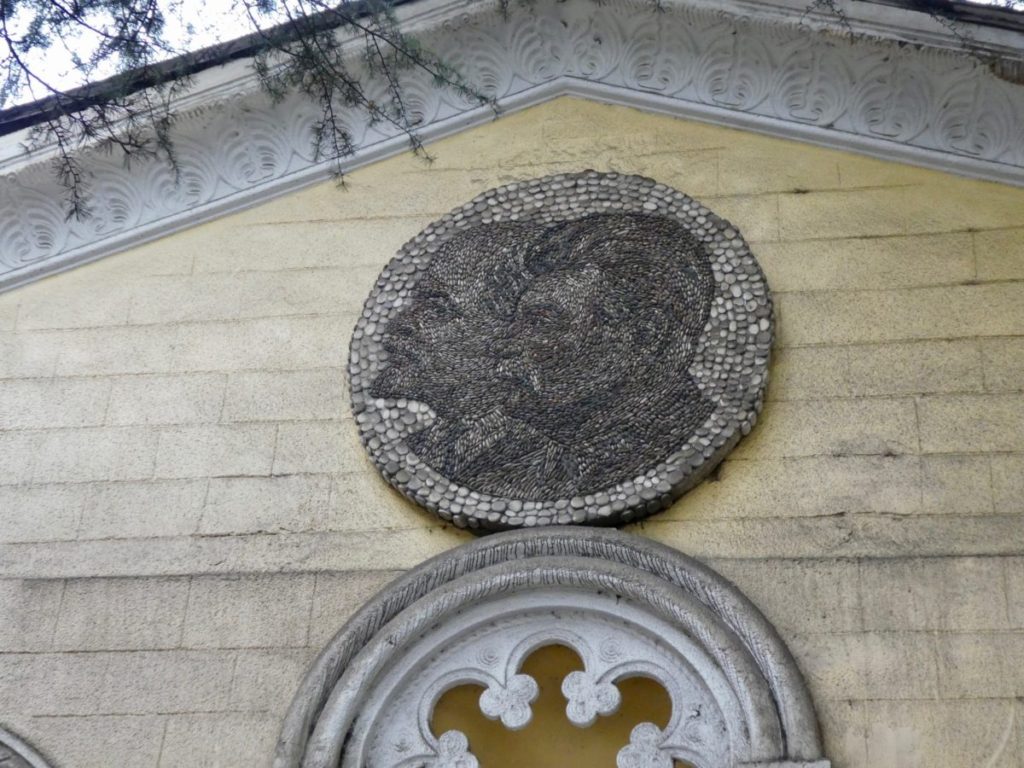
Stalin and Lenin can be seen on this once-grand but now crumbling cable car station.
Riding the Flying Coffins in Chiatura
Judging from their appearance at the time of my visit, there wasn’t much in the way of maintenance over the years. Only a few of the original 17 lines were still operating.
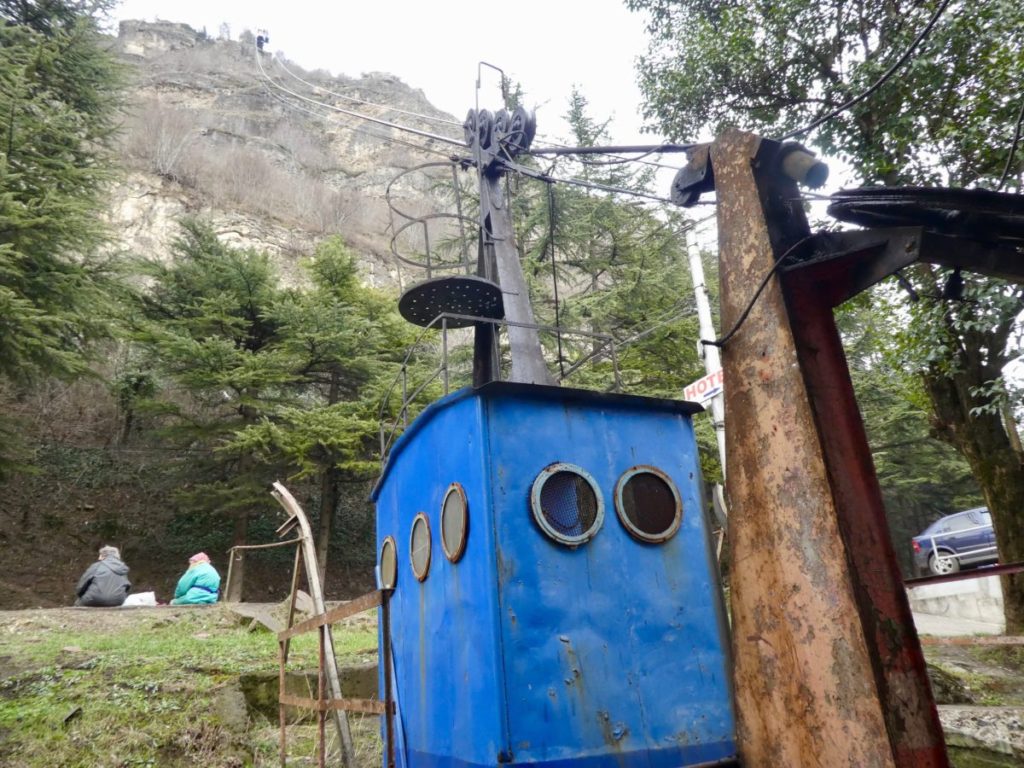
The cable cars of Chiatura outlasted the Soviet Union, despite their rusty-bucket appearance.
We ventured into a battered blue cable car at the bottom of a still-operating line that once ferried workers up a steep cliff that separated their jobs and homes. We didn’t need to buy a ticket for this free ride; we simply waited until there were enough people to fill the car.
I noticed the rotating wheels that pull down a second car from the top, using its weight as a counterbalance to haul the lower car upwards. There is no safety mechanism in the event of a cable break; the only option is a fatal plunge to the bottom. Still, I couldn’t find any record of an accident, except for one on a much newer cable car system in the capital city of Tbilisi in 1990 that killed 20 people.
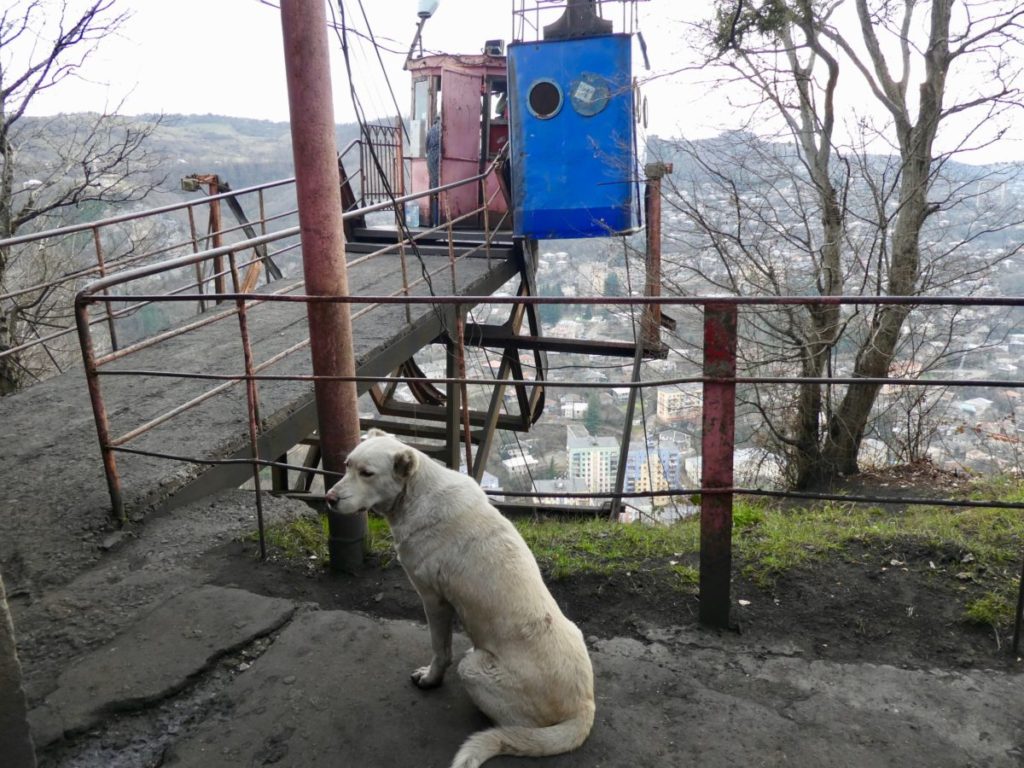
A dog stands guard atop one of the gondolas that once ferried workers to and from their jobs in the manganese mines of Chiatura.
As the rusty bucket climbed almost straight up, the view of the river valley below would have been breathtaking — if it were not covered by iron mesh. At the top, we were greeted by a woman conductor and one of the many tagged street dogs standing guard. After admiring the view, we took the clanking ride to the bottom.
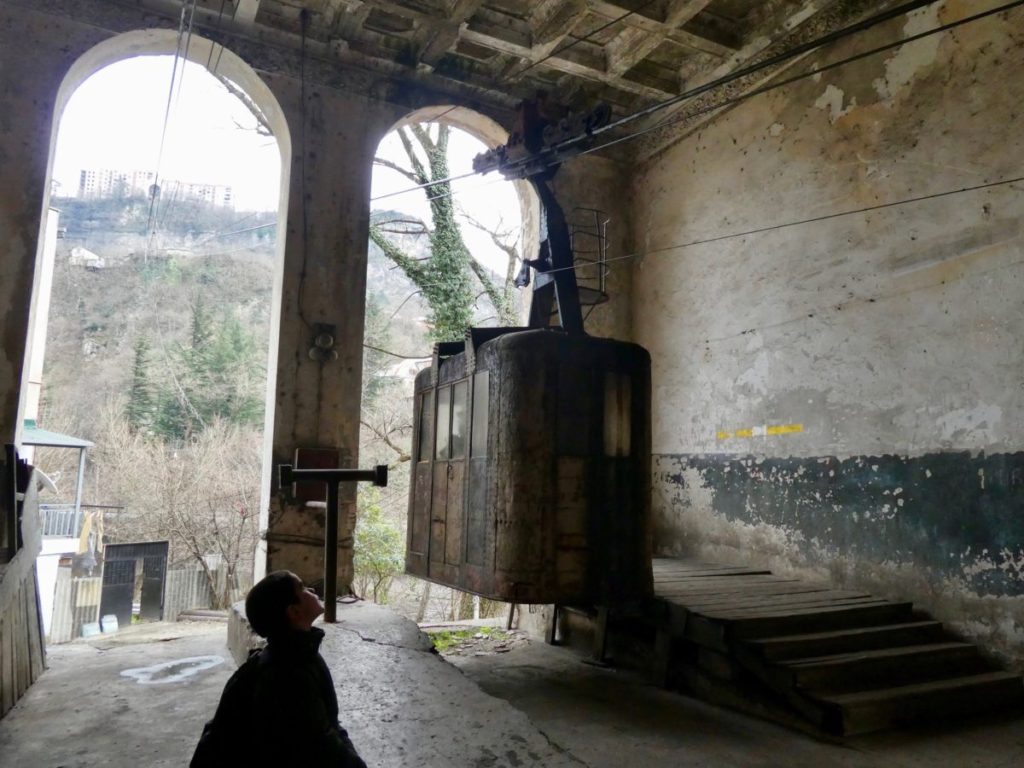
A child waits for a ride at the bottom of one of the two cable car lines still in operation. The once-grand stations reflect a more prosperous time.
Our second ride on a different line took us up to a partly abandoned school and housing complex on the other side of the river. We shared the car with giggling students and their moms. The once-grand architecture of the crumbling cable car stations evoked a bygone time of prosperity.
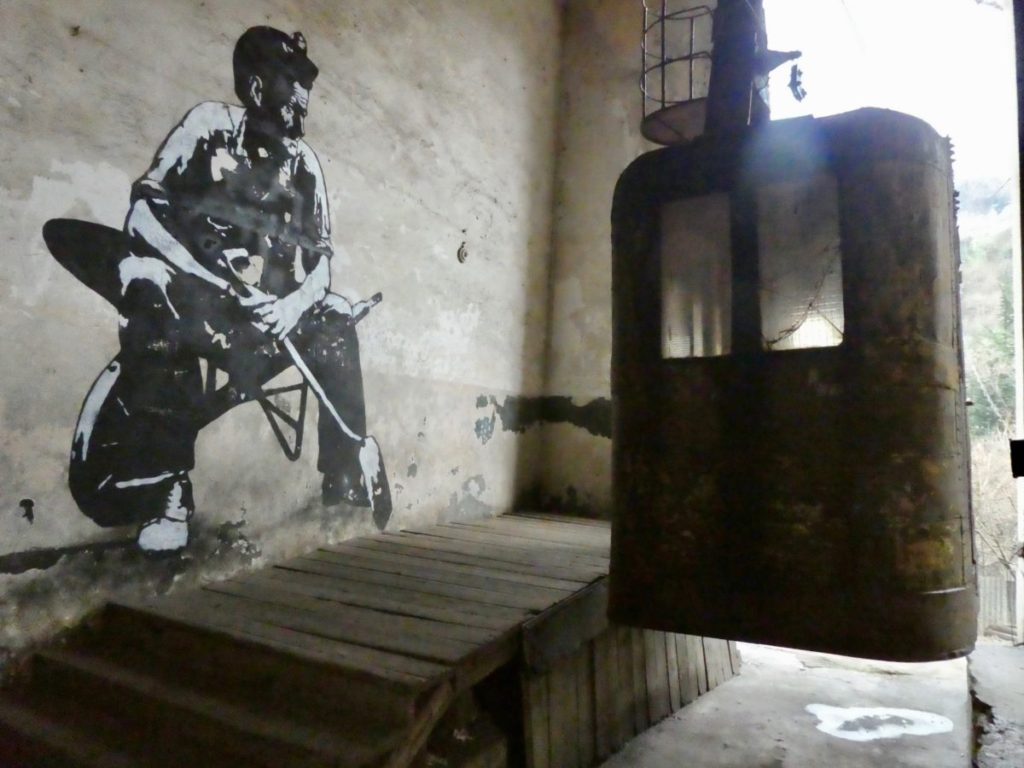
Street Art in a Chiatura cable car station recalls the original purpose of the rusty buckets: public transportation for the miners and their families.
At the top, scruffy dogs barked out a warning to stay away from apartment blocks that looked vacant, except for bits of fresh laundry fluttering out of some of the windows. Chickens pecked in the dark gray mud. As we made our way back to the bottom, a grimy window again blocked the stunning view until one of the schoolgirls opened it so she could snap a selfie with her smartphone.
Rusty as they were, these so-called flying coffins outlasted the Soviet Union itself. Enjoy this video of our experience and read on to find out about some other interesting sights nearby.
Katshki Pillar
The unique cable cars aren’t the only reason to visit Chiatura. A short drive out of town took us to a tiny monastery atop a tall pillar of stone.
With ruins dating back to the 6th century, the monastery complex includes a church, cells for 3 hermits and a wine cellar. Locals venerated it as the Pillar of Life and symbol of the True Cross. A local monk known as Father Maxim is the current resident.
The only way up the 130-foot (40 meter) pillar is by climbing a ladder, but there is a rope and pulley system for hauling up supplies. At one time, men could obtain permission to visit the monastery but women were not allowed. At the time of my visit it was closed to the public.
We probably needed a four-wheel drive to navigate the steep, muddy road to the pillar in the winter, instead of a Toyota Prius. At one point, we all got out of the car so our fearless driver could build up enough speed to get over a particularly slippery hill.
Monastery Mgvimevi
On the outskirts of Chiatura we parked the car and scrambled up a stairway to a monastery and convent carved into the sheer rock. As with most Orthodox holy places, there is a strict dress code. No shorts for the men. Women must wear a skirt and cover their heads. Fortunately for me, scarves were provided. I instantly transformed from hip American baby boomer to Eastern European babushka.
We made our way through intricately carved stone chapels, admiring the icons and the views of the river valley below us. Our guide, Levan, was a fountain of information on the saints depicted in the icons.
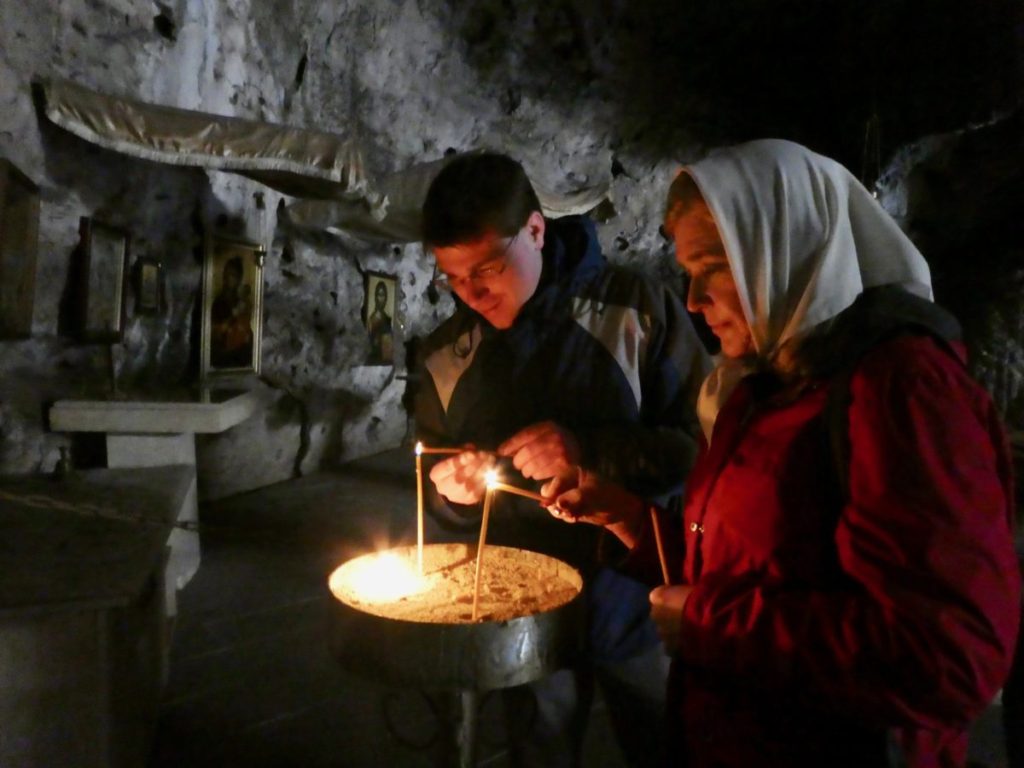
Respecting the dress code, we lit candles and prayed at Mgvimevi Monastery, carved into the solid rock near Chiatura.
Terry’s Travel Tips
Getting there: My son learned about Chiatura from an article in Wizz Air’s inflight magazine. Many visitors come to Chiatura on a day trip. We were on a day trip from Tbilisi with an excellent private guide, Levan Leiashvili, a college student who grew up on a farm and hopes to use his degree in environmental science to develop eco-tourism in Georgia. He arranged for the car and driver. We paid for our tour in US dollars and added a well-earned tip. He’s preparing to launch a new website and I’ll share the link as soon as it’s available.
Getting to Georgia by air from our home base in Ljubljana, Slovenia was challenging. The only connections — through either Warsaw on LOT or Istanbul on Turkish Airlines — required arrivals in the wee hours of the morning and paying another $25 US for an additional partial night in our hotel.

A restaurant called Paris in the town of Chiatura serves yummy Georgian dishes like this lobiani — a flaky quesedilla-like pie with beans and cheese.
Eating in Chiatura: Our guide chose a restaurant in the middle of town called Paris, despite the cuisine being proudly Georgian and not French. Even a vegetarian can enjoy the lobiani, a flaky quesadilla-like bean and cheese khachapuri with fresh tomato-cucumber salad on the side.
Film and Literature: The 2015 movie Partisan was filmed here. Chiatura also plays a role in the fantasy adventure novels by my son, Slovene-American author Andrew Anzur Clement. A doomed Russian princess hides out in a Chiatura cave to conceal a powerful jewel that could determine the future of the world. Could Stalin’s power have come from this mystical object? Find out here.
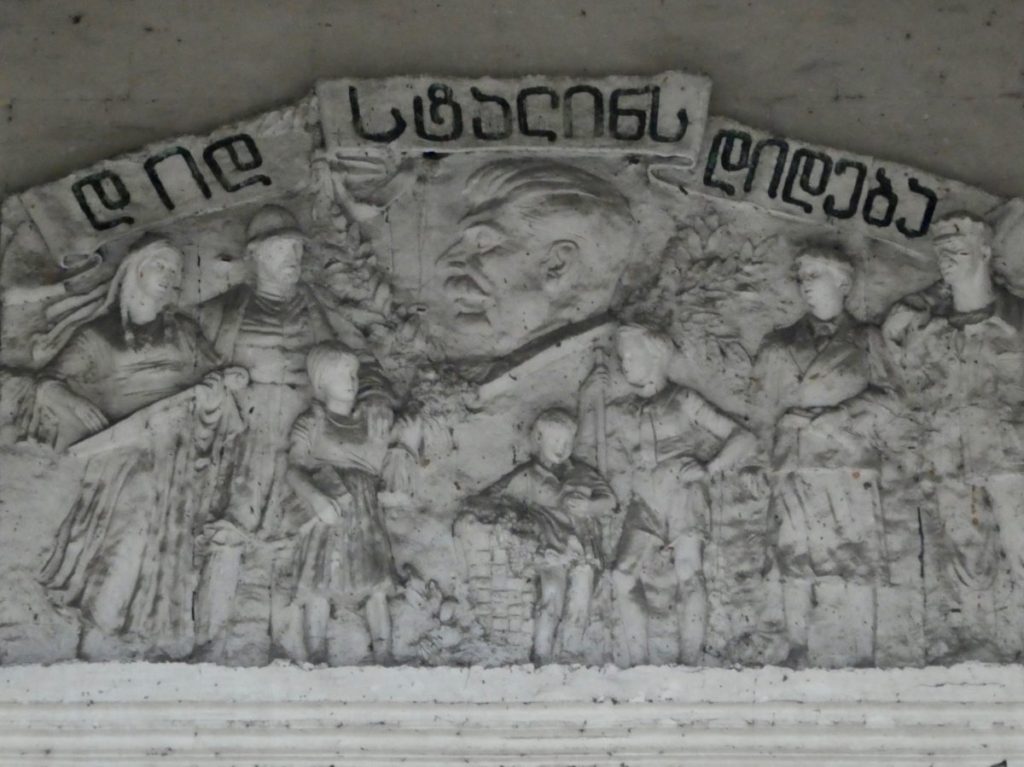
The Soviet dictator Stalin is depicted as a benefactor of the people on the town theater of Chiatura, Georgia.
If you’re planning a trip to Georgia, read my top tips for the capital city of Tbilisi, and a day trip to the birthplace of Stalin in the town of Gori.
Want more travel stories off the beaten track? Like @strangersinthelivingroom on Facebook, and sign up for the occasional email when there is a new post here on the blog. You can follow Terry Anzur on Instagram,Twitter and Pinterest. I’m in the top 1% of Trip Advisor, and you can read all of my reviews @strangersblog on the Trip Advisor feed. Don’t be a stranger!
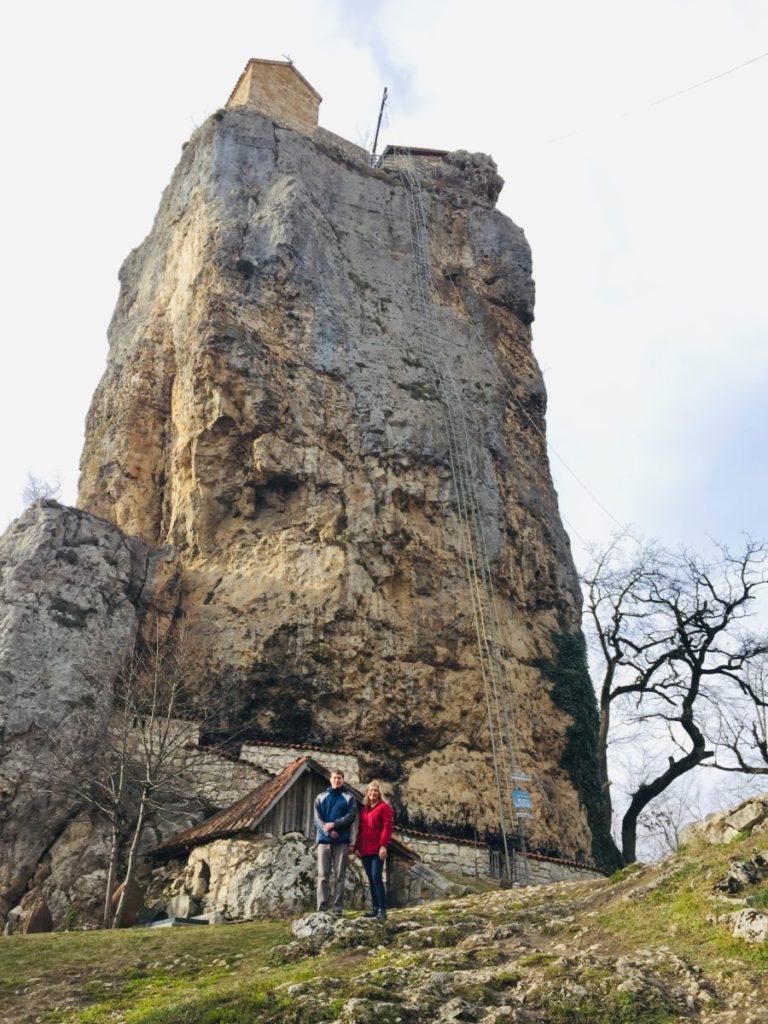
You’ll need the panoramic feature on your Iphone to pose with the Katshki Pillar. Many thanks to our guide, Levan Leiashvili, who snapped this amazing click.

